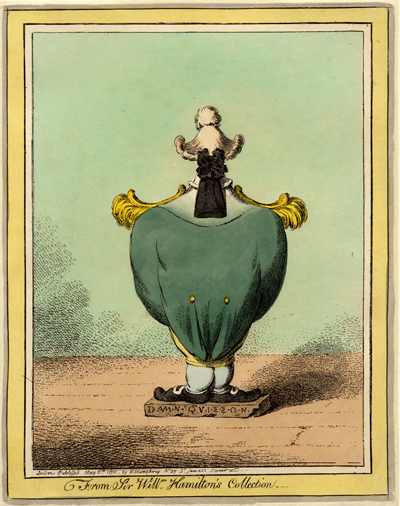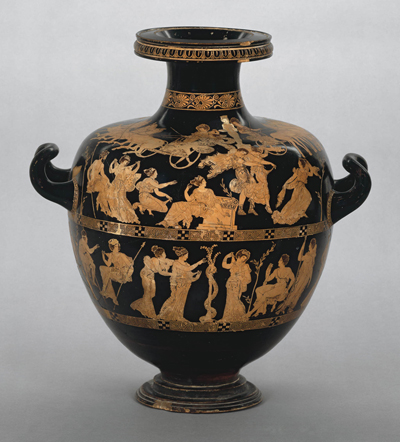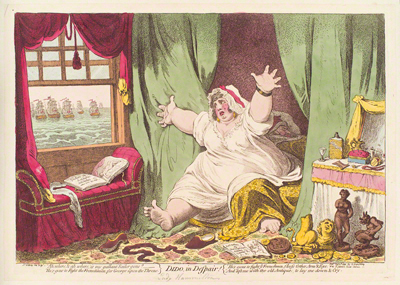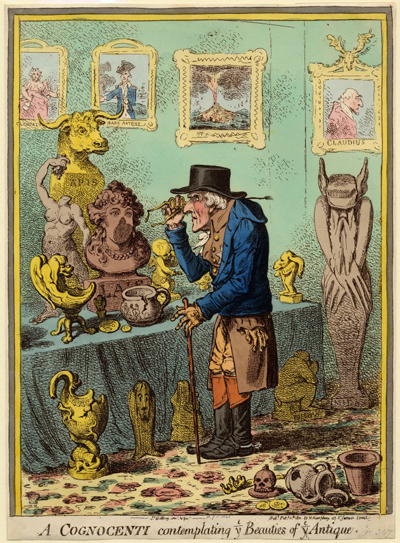From Sir Willm Hamilton's Collection
Using an age-old technique of caricature, the merging of people and objects, Gillray portrays the naval hero Horatio Nelson in the shape of a classical water jar in the household collection of Sir William Hamilton. As the British Museum commentary confirms, the jar Gillray had in mind was likely the Meidias Hydria, one of the prizes of Sir William's collection as suggested by the fact that it is included in Joshua Reynold's formal portrait of Hamilton painted in 1777.

© Trustees of the British Museum

© Trustees of the British Museum
Sir William Hamilton was a English diplomat who served as the British envoy to Naples from 1764 to 1800. In 1801, however, his fame was not owing to his diplomacy but to the outstanding collection of Greek jars, vessels and other antiquities he amassed while he was located in Naples and to the affair his wife was then carrying on with Horatio Nelson, the hero of the Battle of the Nile.
Though of more lasting significance, Hamilton's superb collection was mostly old news. From 1766 to 1776, he had published several volumes of engravings based on his collection, and as a result had been elected to the Society of Antiquaries (1772) and later the Society of Dilettanti (1777). In 1771 he had made arrangements for the collection to be sold to the British Museum, and it was, in fact, owing to this sale that the Meidias Hydria became part of the present British Museum collection. More recently in 1798, Hamilton shipped another substantial collection of Greek vases and other artifacts to England, assisted in the effort by Nelson.
Much more current (and salacious) in 1801 was discussion of Nelson's affair with Hamilton's wife, Emma which had begun while Nelson was recovering from his wounds after the Battle of the Nile and which when they both returned to England in 1800, neither Emma nor Nelson made any attempt to hide. Gillray had already satirized Emma in February 1801 as the lovelorn Dido in Dido in Despair watching her Aeneas (Nelson) sail off with the fleet to the Baltic. Less than a week later, he had then satirized Sir William himself in A Cognocenti Contemplating ye Beauties of ye Antique which combined and contrasted Sir William's preoccupation with antiquities with his blindness to his wife's affair.

© Trustees of the British Museum

© Trustees of the British Museum
In From Sir Willm Hamilton's Collection Gillray turns his attention to the last of the triangle, Nelson. But he does so in a conspicuously oblique way, portraying Nelson with his back turned to the viewer and with an inscription so cryptic that almost 220 years later it is still undeciphered. There are no background objects providing satiric commentary as there are in the prints centered upon Emma and Sir William. Indeed there is nothing in the print itself that can be called satiric. The only clues to identify Nelson are the military epaulettes and the association with Sir William. Why so understated? There are perhaps two reasons for this. One is the notoriety of the Nelson-Hamilton affair. Especially after his two previous prints, Gillray may have felt that he didn't need to do much more than allude to it. The other may have to do with the fact that this is, after all, Nelson, who had now become as celebrated and iconic as the Meidias Hydria itself.
Sources and Reading
- Commentary from the British Museum on From Sir Willm Hamilton's Collection.
- "William Hamilton (diplomat)," Wikipedia
- "Meidias Painter," Wikipedia
Comments & Corrections
NOTE: Comments and/or corrections are always appreciated. To make that easier, I have included a form below that you can use. I promise never to share any of the info provided without your express permission.